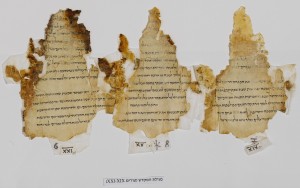Rethinking Rewritten Bible – The Temple Scroll
Molly Zahn discusses rewritten Bible on the ASOR blog:
I think many of my Qumran colleagues would agree with my sense that one of the recurring themes of recent scholarship across all sorts of subfields in the study of the Scrolls is the need to apply a “hermeneutic of suspicion” to our own scholarly constructs: in light of the full publication of the Qumran texts, we have come to realize that what we once regarded as intuitively obvious may in fact be more complex than we suspected. (I am thinking of issues like the Essene Hypothesis, the reconstruction of the community’s history, and the distribution of texts among the various caves, among many others.) The concept of “Rewritten Bible,” and with it my image of a lone scribal rewriter, has not been immune from this development. Discussion of the proper use and application of the term has flourished in the past decade in particular; one notable and widely-accepted proposal is that we speak not of “Rewritten Bible” but of “Rewritten Scripture,” in recognition of the absence of a fixed canon until sometime after 70 CE. My own recent work has complicated the idea of scriptural rewriting in other ways. In particular, my ongoing projects on the Temple Scroll and on the 4QPseudo-Ezekiel manuscripts have made clear to me the difficulty of recovering that one individual scribe and the particular scriptural text that scribe is rewriting. In other words, while the scribe/rewriter and the scriptural text remain the two poles around which the entire concept of Rewritten Scripture orbits, the Qumran textual evidence forces us to think about rewriting in a more complex way.
The enigmatic Temple Scroll, though presented by its author as a rewritten Torah, includes halakhic and exegetical changes and full-blown midrashic interpretations. The scroll also employs harmonistic exegesis, in order to reconcile differences between various texts of the Pentateuch. It is not difficult to discern that the Temple Scroll was redacted from a number of sources, knit together by the author. He then added laws that are similar to those mentioned in the Halakhic Letter, demonstrating that the sources for both halakhic works were the same. In my opinion, the laws of the Temple Scroll and the Halakhic Letter reflect the Sadducean heritage of those who founded the sect.


Leave a Reply